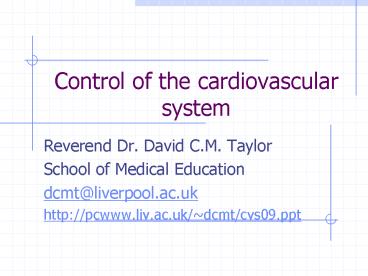Control of the cardiovascular system - PowerPoint PPT Presentation
Title:
Control of the cardiovascular system
Description:
Reverend Dr. David C.M. Taylor School of Medical Education dcmt_at_liverpool.ac.uk http://pcwww.liv.ac.uk/~dcmt/cvs09.ppt What is the role of the cardiovascular system? – PowerPoint PPT presentation
Number of Views:157
Avg rating:3.0/5.0
Title: Control of the cardiovascular system
1
Control of the cardiovascular system
- Reverend Dr. David C.M. Taylor
- School of Medical Education
- dcmt_at_liverpool.ac.uk
- http//pcwww.liv.ac.uk/dcmt/cvs09.ppt
2
What is the role of the cardiovascular system?
3
Blood Pressure
- Depends upon the amount of blood leaving the
heart - cardiac output
- and the resistance of the vasculature
- total peripheral resistance
4
Peripheral Resistance
5
Peripheral resistance 2
6
Cardiac Output
- Heart rate x stroke volume
7
Factors affecting stroke volume
Preload
Afterload
Contractility
8
Preload
- increased end-diastolic volume stretches the
heart - cardiac muscles stretch and contract more
forcefully - Frank-Starling Law of the heart
9
Starlings Law
2.2 ?m
3.8 ?m
1.8 ?m
100 80 60 40 20
Tension developed
40 60 80 100 120 140 160
Percentage sarcomere length (100 2.2 ?m)
10
Contractility-Inotropic effect
- positive inotropic agents
- increase available intracellular Ca2
- increase number of actinomyosin binding sites
- increase force of contraction
- positive inotropic agents
- sympathetic stimulation
- catecholamines
- glucagon
- thyroid hormones
- increased extracellular Ca2
11
Afterload
- decreased arterial blood pressure during diastole
- decreased afterload
- semilunar valves open sooner when blood pressure
in pulmonary artery aorta is lower
- afterload
- blood pressure
- viscosity of blood
- elasticity of arteries
12
(No Transcript)
13
Heart Rate
- Nervous system
- increased sympathetic
- decreased parasympathetic
- Chemicals
- catecholamines
- thyroid hormones
- moderate Ca2 increase
14
Heart Rate 2
- Other factors
- age
- gender
- fitness
- body temperature
15
Pacemaker activity
- The rhythm of the pump is provided by the
pacemaker activity of some specialized muscle
cells in the wall of the right atrium - the
sinoatrial node
16
Chronotropic effect
17
Hypertension
- David Taylor
- School of Medical Education
18
Hypertension
- Excellent article
- ABC of Hypertension The pathophysiology of
hypertension, Beevers G, Lip GYH and OBrien E
(2001) BMJ, 322912-916 - Upto 5 of patients with hypertension have it as
secondary to some other disease (e.g. renal
disease) - The rest have essential hypertension
19
The story so far...
- http//pcwww.liv.ac.uk/dcmt/cvs09.ppt
- intrinsic (Starlings Law)
- extrinsic (principally autonomic)
Stroke volume
Cardiac output
Heart rate
20
Postulated mechanism
- Increased sympathetic activity
- Leads to increased cardiac output
- And peripheral vasoconstriction (to protect the
capillary beds) - Drop in blood flow
- Triggers renin-angiotensin system
21
Evidence
- Cross transplantation studies show that essential
hypertension has its origins in the kidneys. - Human and animal studies
- Little evidence that stress is involved
- But, of course, drugs that decrease sympathetic
activity lower blood pressure.
22
Control
Autonomic N.S.
Volume
ADH
Pressure
Chemicals
Angiotensin
Local Blood Flow
23
Pressure
- Sensed by baroreceptors
- in carotid arteries and aortic arch
- an increase in pressure causes a decrease in
sympathetic activity - a decrease in pressure causes an increase in
sympathetic activity
24
Volume
- Sensed by atrial volume receptors
- A decrease in volume
- causes an increase in ADH secretion
- and a decrease in ANF secretion
25
Chemicals
- A decrease in O2, or more usually an increase in
CO2 or H2 causes an increase in chemoreceptor
activity which - increases sympathetic activity
26
Local Blood Flow (kidney)
Vasoconstriction
27
Hormones
- Angiotensin II is a vasoconstrictor
- Aldosterone increases vascular sensitivity to
Angiotensin II - ADH (anti-diuretic hormone) increases water
reabsorption - ANF decreases sodium reabsorption
28
Overview
ADH
vol
baro
veins
capillary pressure
chemo
renin/angiotensin
aldosterone
kidney
29
Shock
- David Taylor
- School of Medical Education
30
Shock
- Stage 1 Compensated/Nonprogressive
- mechanisms work as planned
- Stage 2 Decompensation/Progressive
- if blood volume drops more than 15 - 25
- Stage 3 Irreversible
31
Progressive shock
- depression of cardiac activity
- bp lt60 mmHg poor flow through coronary arteries
leads to ischemia - depression of vasoconstriction
- bp 40 - 50 mmHg
- increased capillary permeability
- caused by hypoxia
- clotting, cell destruction, acidosis































